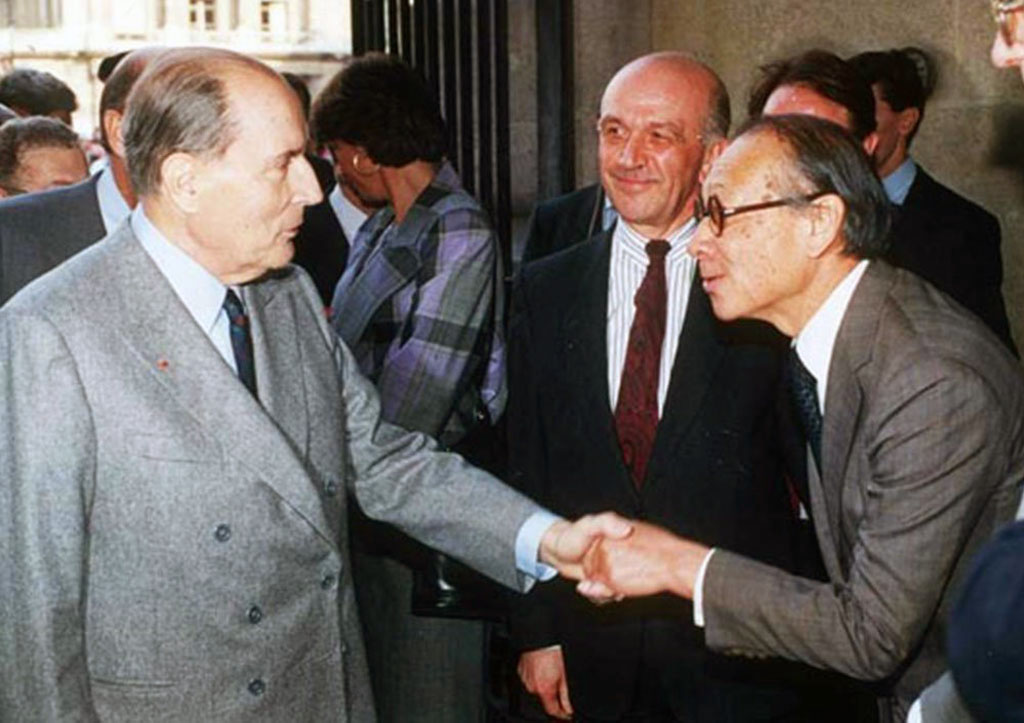08-11-2017 // CLIENT-SHAPED URBANISM

President François Mitterrand and I. M. Pei at the inauguration
of the Louvre Pyramid in Paris on March 29, 1989, ©Belga Image
Client-shaped Urbanism
By Bernd Upmeyer
According to Alejandro Zaera-Polo, in a recent interview on Yale University Radio, you do not need a big budget to produce good architecture, but a good client who is sophisticated and intelligent. We could not agree more. Yet, the importance of the client in shaping our built environment, whether it comes to buildings, neighbourhoods or entire cities, is not included sufficiently in urban and architectural debates and discussions and thus largely forgotten, underestimated, and under-investigated. This is why we wish to dedicate an entire issue to the topic of “Client-shaped Urbanism“.
To some extent we touched on the subject around seven years ago in our issue #12 entitled “Real Urbanism” that dealt with the power of the real estate industry, and discussed in particular how real estate developers shape our cities. We showed how cities can easily be reduced to machines for making and spending money creating a revenue-focused and profit-driven urban planning culture. However, with this new issue of MONU we do not wish to repeat the debate on the real estate industry in general, but open it up, build upon it, and focus on the particular figure, group, company, association, administrative body, or institute, whether public, private, a combination of both, or something else, that is the “client”.
We want to find out, without repeating clichés, what the values of clients are, their goals, their objectives, their fears, their motivations and the consequences of all of this for cities and the buildings of cities. However, this does not mean this new issue of MONU merely aims to disapprove of, disqualify or criticize clients as the driving force behind everything that goes wrong in architecture and urbanism. Because, as we showed in MONU #12, in more cases than we expect clients might appear to be even more concerned about the quality of urban spaces than architect or urban designers, which makes them crucial participants in the shaping and creating of spaces. Therefore, as we at MONU have been since our very first issue, we are concerned with, and aim for, making our cities better by gaining a greater understanding of how cities work, and thus we intend to discuss in this issue how to improve things such as the collaboration of clients with architects or urban designers for a more satisfying outcome for everybody involved and especially for the users and inhabitants of cities.
Thus, with “Client-shaped Urbanism” we aim to understand how, for example, the communication between clients and designers can be advanced, and how an earlier engagement and involvement of both parties in the design process and decision-making can create a difference. What kind of design methods need to be developed for better partnerships and results? How can the destructive love and hate relationship between both sides, such as the infamous one between Edith Farnsworth and Mies van der Rohe, be turned into something constructive and more successful? What can we learn from “clients” such as the former President of France, François Mitterrand, who was a strong promoter of culture during his time in office and responsible for many modern monuments in Paris such as the Louvre Pyramid or the Grande Arche? Which projects might have never happened had there not been an ambitious and creative client, who fought for them until their realisation? We probably need also to look at how architects and urban designers are educated, because usually topics such as “how to work with clients” are ignored at universities and academies, where clients are largely considered and treated as the enemy. And since increasingly clients that initiate urban developments are no longer necessarily public, but private parties, new challenges and problems arise for designers – especially since the rise of the market economy and an ever increasing globalisation with all its concomitant economical, social, and cultural changes – we wish to debate this too.
Title: Client-shaped Urbanism
Author: Bernd Upmeyer
Date: November 2017
Type: Call for Submissions, MONU #28
Publications: MONU – Magazine on Urbanism
Publisher: Board Publishers
Location: Rotterdam, The Netherlands